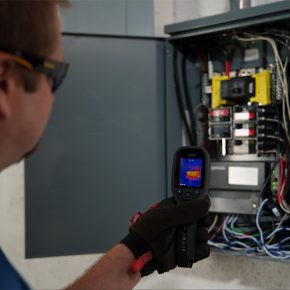The plug-in route to energy saving
THE PLUG-IN ROUTE TO ENERGY SAVING
Steve Dyson of Hager explains how plug-in meters can provide the answer to energy monitoring
Bespoke meter enclosure board showing the plug-in cabling
Economic news has recently been focused on the falling price of energy, but the fact that the financial cost of electricity may fall doesn’t remove Government emphasis on the bigger issues of the cost to the planet. Regardless of the cost of energy, building owners are increasingly responsible for monitoring and reducing their consumption in order to contribute to the national and global efforts to reduce CO² emissions.
Central to the effort of controlling the energy consumption of buildings is the use of metering. In larger and more complex premises, these can be whole-building management systems which monitor and control every aspect of electrical consumption, but in many smaller commercial buildings, there is neither the need, nor the budget, for this level of sophistication. However, the changes to Parts L2A and L2B of the building regulations do require buildings with a total useful floor area greater than 1,000m², such as schools, small office blocks, hotels and retail premises, to have the ability to meter electrical energy at distribution boards.
Enabling building owners or managers to manage energy usage
The purpose of these regulations is to enable building owners or managers to obtain actionable information about their energy usage. One area in most buildings where there is potential for savings, in both usage and cost, is in general and display lighting which, it is estimated, can be responsible for between 20 and 40 per cent of energy consumed, so a minimum requirement is the ability to monitor the energy consumption of a building’s lighting.
Detailed within the building regulations guidelines for lighting are the recommended minimum standards for metering of general and display lighting in new and existing buildings, the options being:
a kWh meters on dedicated lighting circuits in the electrical distribution or
b local power meter coupled to or integrated in the lighting controllers of a lighting of building management system or
c a lighting management system that can calculate the consumed energy and make this information available to a building management system or in an exportable file format. (This could involve logging the hours run and the dimming level and relating this to the installed load.)
Bespoke meter enclosure board showing meters fitted
As well as placing a responsibility on a building’s designers and owners or tenants, the requirement for additional metering is putting more demands on installers and contractors and, some may feel, is moving them out of their comfort zone and into areas of expertise that they have not previously had to cope with.
There is, however, a solution that meets both the requirements of the building regulations and offers a simple but effective technology that is compatible with the experience of any qualified electrical installer. That solution is a plug-in energy-monitoring meter that connects to the pulsed output of various kWh meters in the building.
From the installer’s point of view, plug-in meters, like those manufactured by Hager, offer a range of benefits, not least labour savings of around 90 per cent compared with traditional wiring methods.
Plug-in meters can be DIN-rail mounted for split loads, enabling the connection of two three-phase current transformers into one meter, typical applications including split load distribution boards. Plugability’ is simple and involves simply plugging one lead into the multi-function power meter and the other into the three-phase current transformer.
If more than one meter is involved, it is simply a case of plugging the ready-made linking lead connector from the first to the second meter. Up to 32 energy meters can be powered from a single power source. Where panel mounting is required, the secondary meter is powered up by connecting it to the supply and it is then plugged into the multi-function power meter and connected to the three-phase current transformer.
Enhanced safety with Plug-in meters
Plug-in meters are safer than using traditional current transformers because they incorporate the resistive shunts usually located within the power meter. This means that the secondaries are always loaded, eliminating the possibility of dangerously high voltages developing during open circuit conditions.
Other fitted components also provide redundancy in the event that the resistor should fail. This allows the meter-to-current-transformer lead to be disconnected without the need for secondary shorting terminals, again saving money and reducing downtime. The design of both the current transformers and the meters allow plug-in connectors to be used for both current and voltage input/output.
The demands for energy monitoring can only increase as we see the energy-saving bar being raised ever higher. From the user’s point of view, monitoring energy consumption with the use of sub-meters helps understand where money can be saved and at the same time helps to reduce carbon emissions. For the installer, the use of plug-in meters turns this scenario from challenge to opportunity, offering a quick and easy solution to the demand for energy monitoring technology.
For more information on Hager’s plug-in meters visit: www.hager.co.uk/plug-inmeters
Latest news

25th April 2025
Quicker and Easier Inspections with High Performance FLIR Testing Solutions
FLIR, a Teledyne Technologies company, introduces its PV range of inspection solutions to expedite panel installation and maintenance at solar farms, commercial buildings, and residential buildings.
Posted in Articles, Building Industry News, Building Products & Structures, Building Services, Facility Management & Building Services, Information Technology, Innovations & New Products, Research & Materials Testing, Restoration & Refurbishment, Retrofit & Renovation, Sustainability & Energy Efficiency, Thermal Imaging and Monitors
25th April 2025
Schlüter-Systems: Common costly mistakes when renovating a bathroom
With nearly six decades of experience in the bathroom world, Schlüter-Systems knows all there is to know about the challenges of installing a perfect one!
Posted in Articles, Bathrooms & Toilets, Bathrooms, Bedrooms & Washrooms, Building Industry News, Building Products & Structures, Building Services, Damp & Waterproofing, Drainage, Drainage Services, Drainage, Guttering, Soffits & Fascias, Heating, Ventilation and Air Conditioning - HVAC, Interior Design & Construction, Interiors, Membranes, Pipes & Fittings, Plumbing, Restoration & Refurbishment, Retrofit & Renovation, Walls
25th April 2025
Newcastle United enhances fans’ experience with Stannah escalators
Newcastle United Football Club has introduced two new Stannah escalators as part of a refurbishment of its on-site merchandising outlet.
Posted in Accessibility, Articles, Building Industry News, Building Products & Structures, Building Services, Case Studies, Facility Management & Building Services, Restoration & Refurbishment, Retrofit & Renovation
24th April 2025
Gemini: Using Data Loggers to Help Analyse Environmental Conditions and Energy Usage in Buildings
Gemini Tinytag Data Loggers record environmental parameters over time, allowing conditions to be measured, documented, analysed, and validated.
Posted in Articles, Building Industry News, Building Products & Structures, Building Services, Facility Management & Building Services, Health & Safety, Heating Systems, Controls and Management, Heating, Ventilation and Air Conditioning - HVAC, Information Technology, Research & Materials Testing, Restoration & Refurbishment, Retrofit & Renovation, Sustainability & Energy Efficiency, Thermal Imaging and Monitors
 Sign up:
Sign up: